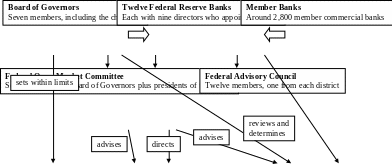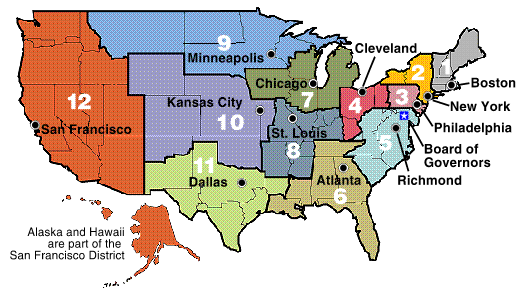
- •Central banking
- •5.2 Look through the following vocabulary notes which will help you understand the text and discuss the topic.
- •5.3 Reading
- •Policy tools
- •5.4 Comprehension
- •5.4.1 Answer the questions using the active vocabulary.
- •5.4.2 Mark these statements t(true) or f(false) according to the information in the Text and Glossary. If they are false say why.
- •5.5 Language practice
- •5.5.1 Match the English terms in the left-hand column with the definition in the right-hand column.
- •5.5.2 Complete the following text using the suitable words or phrases from the box.
- •Differences between the European System of Central Banks and the Federal Reserve System
- •5.5.3 Complete the texts. Replace the Russian words and phrases by the English equivalents.
- •5.5.4 Text for discussion.
- •The Case against Independence
- •5.6 Render the passage in English using the English equivalents of the italicized phrases given in Russian. Express the main idea of the passage in one sentence or entitle it.
- •Professional English Unit 5 Reading Self – Control Test
- •1. Which of the following is the main idea of the text?
- •2. What is most likely the audience the text is addressed to?
- •3. It can be derived from the text that
- •4. It cannot be inferred from the text that
- •5. Judging by what you have derived from the text, which do you think of the following defines the term ‘open market operations’?
- •10. What is most likely the subject of the extract which is missing from this text?
- •Bank panic: the simultaneous failure of many banks, as during a financial crisis.
- •Board of governors of the federal reserve system: a board with seven governors (including the chairman) that plays an essential role in decision making within the Federal Reserve System.
5.3 Reading
The Federal Reserve System
Of all the central banks in the world, the Federal Reserve System probably has the most unusual structure. To understand why this structure arose, we must go back to before 1913, when the Fed was created.
Before the twentieth century, a major characteristic of American politics was the fear of centralized power. The 1907 bank panic resulted in such widespread bank failures and such substantial losses to depositors that the public was finally convinced that a central bank was needed to prevent future bank panics. The hostility of the American public to banks and centralized authority created great opposition to the establishment of a single central bank like the Bank of England. Because of the heated debates on this issue, a compromise was struck. In the great American tradition, Congress wrote an elaborate system of checks and balances into the Federal Reserve Act of 1913, which created the Federal Reserve System with its 12 regional Reserve banks.
The writers of the Federal Reserve Act wanted to diffuse power along regional lines, between the private sector and the government, and among bankers, business people, and the public. Thus the Fed includes the following entities: the Federal Reserve banks, The Board of Governors, The Federal Open Market Committee, the Federal Advisory Council, and around 2,800 member commercial banks. Figure 1 outlines the relationships of these entities to one another and to the three policy tools of the Fed: open market operations, the discount rate, and the reserve requirements.

Reserve requirements
Open market operations
Discount rate
establish



Policy tools
Figure 1 Structure and Responsibility for Policy Tools in the Federal Reserve System
Each of the 12 Federal Reserve districts has one main Federal Reserve bank, which may have branches in other cities in the district. The locations of these districts, the Federal Reserve banks, and their branches are shown in Figure 2.
The Twelve Federal Reserve Districts |
||
|
|
|
Figure 2 The Twelve Federal Reserve Districts
Each of the Federal Reserve banks is a quasi-public (part private, part government) institution owned by the private commercial banks in the district that are members of the Federal Reserve System. These member banks have purchased stock in their district Federal Reserve bank (a requirement membership), and the dividends paid by the stock are limited by law to 6% annually. The member banks elect six directors for each district bank; three more are appointed by the Board of Governors. Together, these nine directors appoint the president of the bank (subject to the approval of the Board of Governors).
The 12 Federal Reserve banks perform the following functions:
clear checks;
issue new currency;
withdraw damaged currency from circulation;
administer and make discount loans to banks in their districts;
evaluate proposed mergers and applications for banks to expand their activities;
act as liaisons between the business community and the Federal Reserve System;
examine bank holding companies and state-charted member banks;
collect data on local business conditions;
use their staffs of professional economists to research topics related to the conduct of monetary policy.
The 12 Federal Reserve banks are involved in monetary policy in several ways:
Their directors “establish” the discount rate (although the discount rate in each district is reviewed and determined by the Board of Governors).
They decide which banks, member and nonmember alike, can obtain discount loans from the Federal Reserve bank.
Their directors select one commercial banker from each district to serve on the Federal Advisory Council, which consults with the Board of Governors.
Five of the 12 bank presidents each have a vote on the Federal Open Market Committee, which directs open market operations (the purchase and sale of government securities that affect both interest rates and the amount of reserves in the banking system).
All national banks (commercial banks charted by the Office of the Comptroller of the Currency) are required to be members of the Fed. Commercial banks charted by the states are not required to be members, but they can choose to join. Currently, 37% of the commercial banks in the United States are members of the Fed.
According to the Monetary Control Act of 1980 all depository institutions became subject to the same requirements to keep deposits at the Fed, so member and nonmember banks would be on equal footing in terms of reserve requirements. In addition, all depository institutions were given access to the Fed facilities such as the discount window and the Fed check clearing, on an equal basis.
At the head of the Federal Reserve System is the seven-member Board of Governors, headquartered in Washington, DC. Each governor is appointed by the president of the United States and confirmed by the Senate. The Board of Governors is actively involved in decisions concerning the conduct of monetary policy. All seven governors are members of the FOMC and vote on the conduct of open market operations. The Board also sets reserve requirements and effectively controls the discount rate. The Board also sets margin requirements, the fraction of the purchase price of securities that has to be paid for with cash rather than borrowed funds. Finally, the Board has substantial bank regulatory functions: it approves bank mergers and applications for new activities, specifies the permissable activities of bank holding companies, and supervises the activities of foreign banks in the United States.
Because open market operations are the most important policy tool that the Fed has for controlling the money supply, the FOMC is necessarily the focal point for policymaking in the Federal Reserve System.

